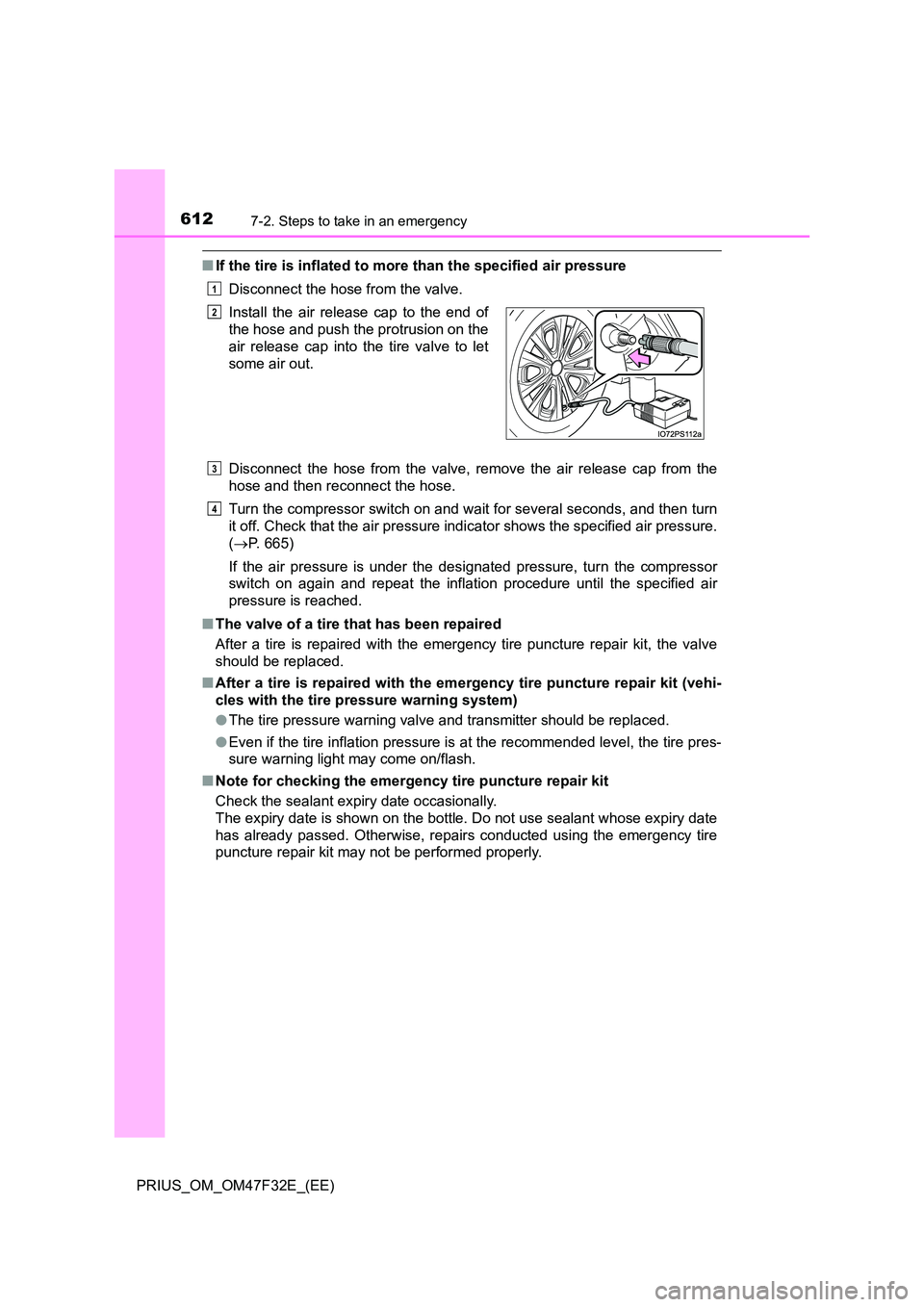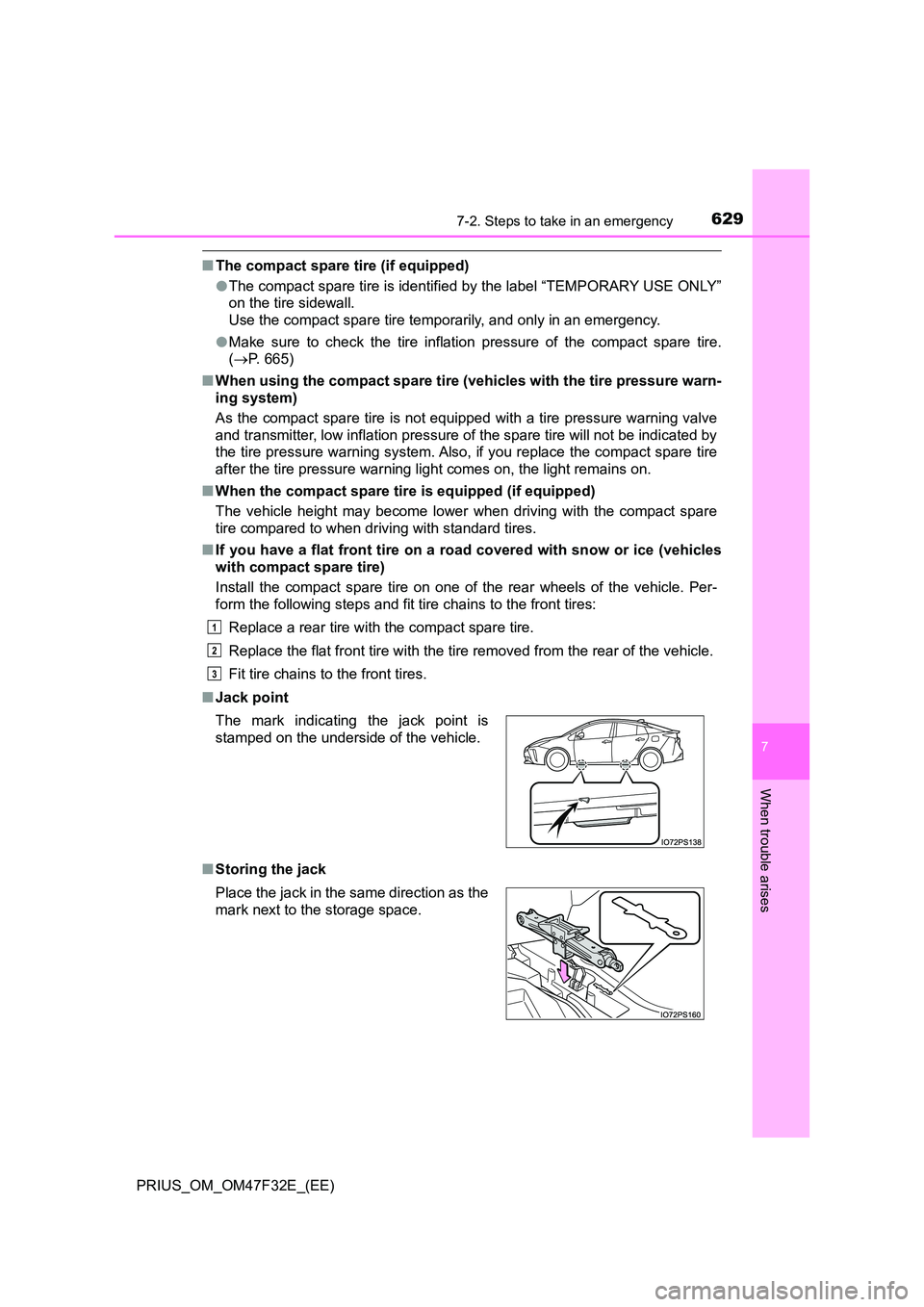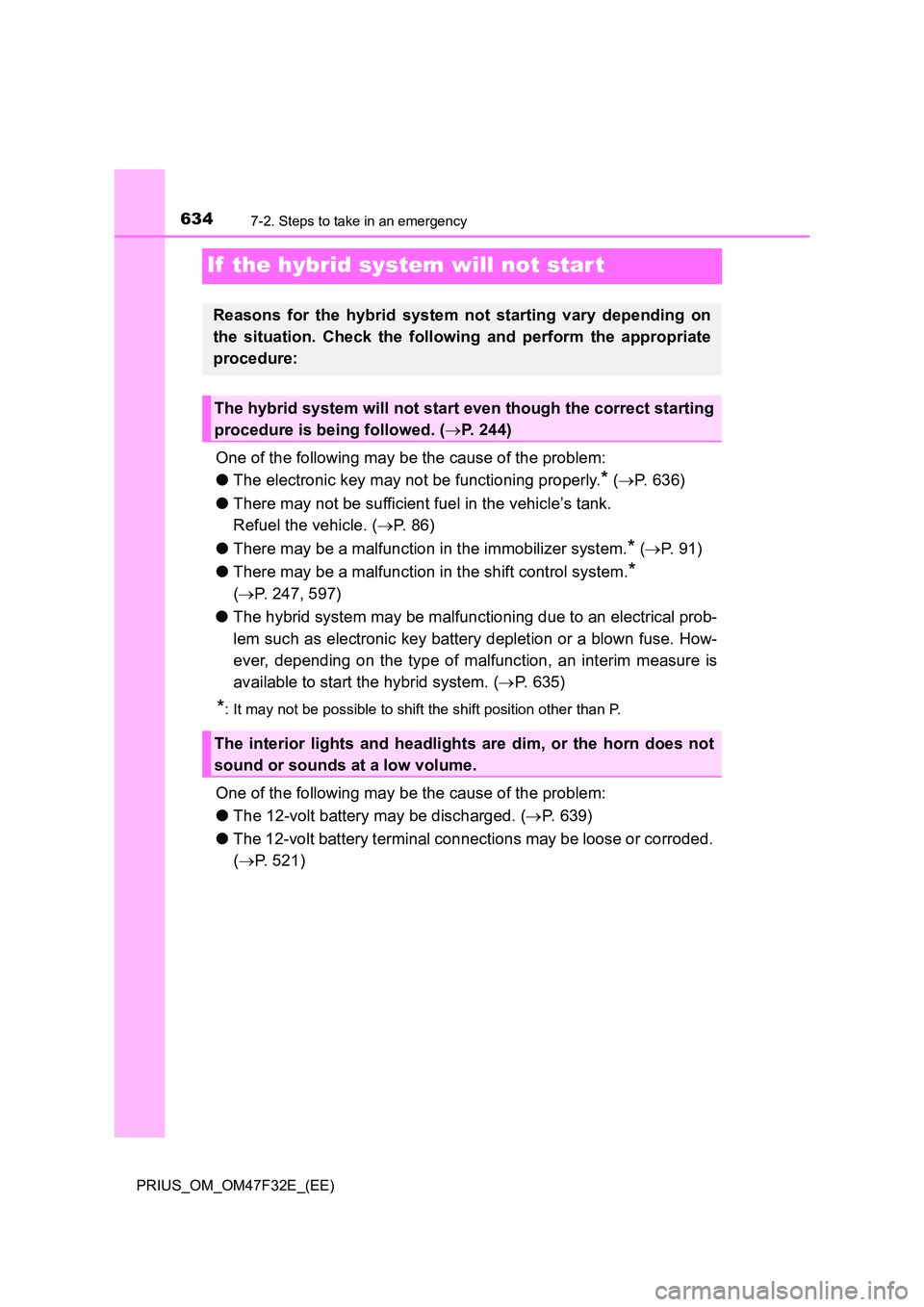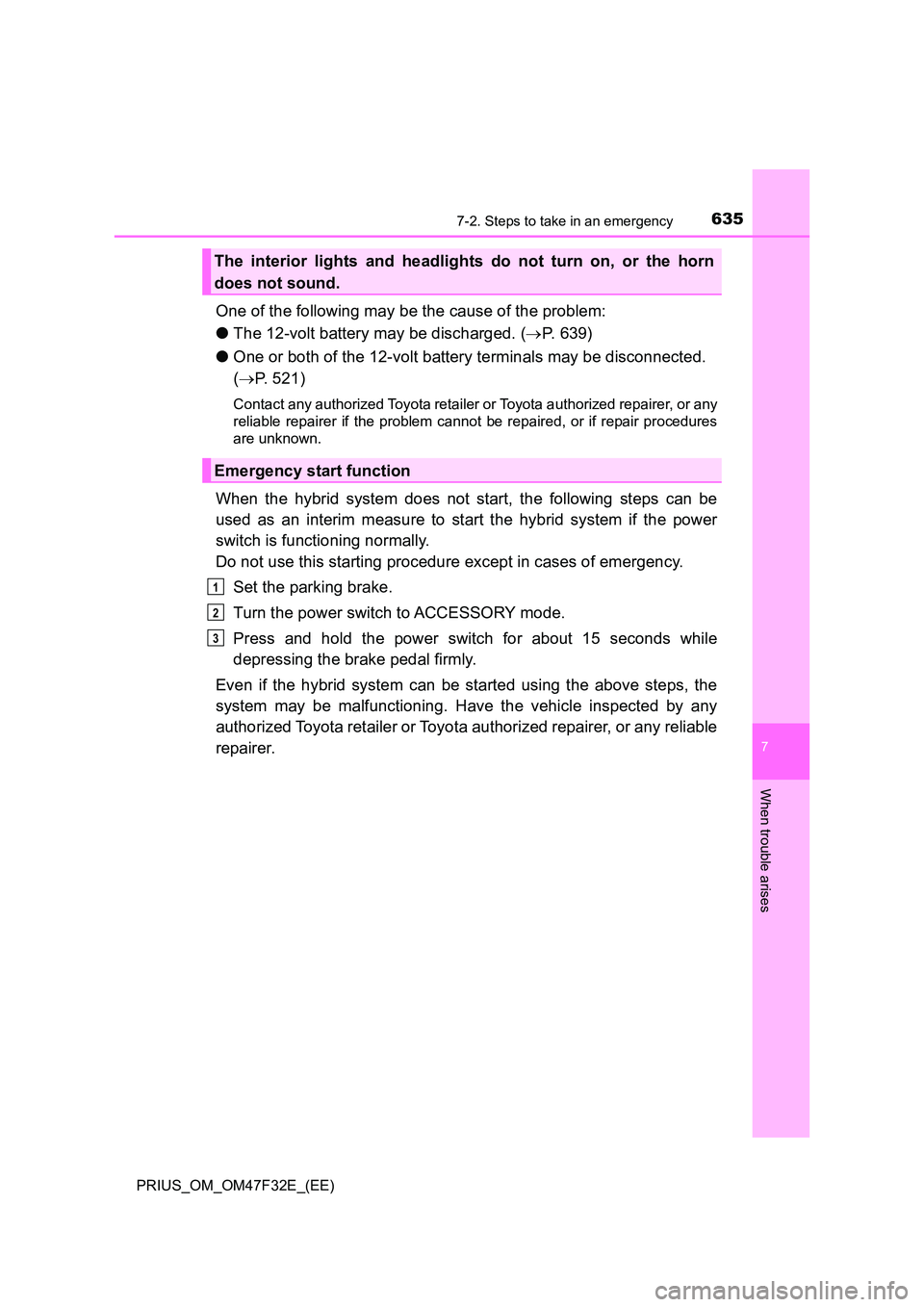Page 614 of 770

6127-2. Steps to take in an emergency
PRIUS_OM_OM47F32E_(EE)
■If the tire is inflated to more than the specified air pressure
Disconnect the hose from the valve.
Disconnect the hose from the valve, remove the air release cap from the
hose and then reconnect the hose.
Turn the compressor switch on and wait for several seconds, and then turn
it off. Check that the air pressure indicator shows the specified air pressure.
( P. 665)
If the air pressure is under the designated pressure, turn the compressor
switch on again and repeat the inflation procedure until the specified air
pressure is reached.
■ The valve of a tire that has been repaired
After a tire is repaired with the emer gency tire puncture repair kit, the valve
should be replaced.
■ After a tire is repaired with the emergency tire puncture repair kit (vehi-
cles with the tire pressure warning system)
● The tire pressure warning valve and transmitter should be replaced.
● Even if the tire inflation pressure is at the recommended level, the tire pres-
sure warning light may come on/flash.
■ Note for checking the emergency tire puncture repair kit
Check the sealant expiry date occasionally.
The expiry date is shown on the bottle. Do not use sealant whose expiry date
has already passed. Otherwise, repairs conducted using the emergency tire
puncture repair kit may not be performed properly.
Install the air release cap to the end of
the hose and push the protrusion on the
air release cap into the tire valve to let
some air out.
1
2
3
4
Page 626 of 770
6247-2. Steps to take in an emergency
PRIUS_OM_OM47F32E_(EE)
Chock the tires.
For vehicles with 195/65R15
tires: Remove the wheel orna-
ment using the wrench.
To prevent damage, cover the tip of
the wrench with a rag.
Slightly loosen the wheel nuts
(one turn).
Replacing a flat tire
1
Flat tireWheel chock positions
FrontLeft-hand sideBehind the rear right-hand side tire
Right-hand sideBehind the rear left-hand side tire
RearLeft-hand sideIn front of the front right-hand side tire
Right-hand sideIn front of the front left-hand side tire
2
3
Page 627 of 770
6257-2. Steps to take in an emergency
PRIUS_OM_OM47F32E_(EE)
7
When trouble arises
Turn the tire jack portion by
hand until the center of the
recessed portion of the jack is
in contact with the center of the
jack point.
Assemble the jack handle and
the wheel nut wrench as shown
in the illustration.
Raise the vehicle until the tire is
slightly raised off the ground.
Remove all the wheel nuts and
the tire.
When resting the tire on the
ground, place the tire so that the
wheel design faces up to avoid
scratching the wheel surface.
Jack point
4A
5
6
7
Page 631 of 770

6297-2. Steps to take in an emergency
PRIUS_OM_OM47F32E_(EE)
7
When trouble arises
■The compact spare tire (if equipped)
● The compact spare tire is identified by the label “TEMPORARY USE ONLY”
on the tire sidewall.
Use the compact spare tire temporarily, and only in an emergency.
● Make sure to check the tire inflation pressure of the compact spare tire.
( P. 665)
■ When using the compact spare tire (vehicles with the tire pressure warn-
ing system)
As the compact spare tire is not equipped with a tire pressure warning valve
and transmitter, low inflation pressure of the spare tire will not be indicated by
the tire pressure warning system. Also, if you replace the compact spare tire
after the tire pressure warning light comes on, the light remains on.
■ When the compact spare tire is equipped (if equipped)
The vehicle height may become lower when driving with the compact spare
tire compared to when driving with standard tires.
■ If you have a flat front tire on a road covered with snow or ice (vehicles
with compact spare tire)
Install the compact spare tire on one of the rear wheels of the vehicle. Per-
form the following steps and fit tire chains to the front tires:
Replace a rear tire with the compact spare tire.
Replace the flat front tire with the tire removed from the rear of the vehicle.
Fit tire chains to the front tires.
■ Jack point
■ Storing the jack
The mark indicating the jack point is
stamped on the underside of the vehicle.
Place the jack in the same direction as the
mark next to the storage space.
1
2
3
Page 636 of 770

6347-2. Steps to take in an emergency
PRIUS_OM_OM47F32E_(EE)
If the hybrid system will not star t
One of the following may be the cause of the problem:
● The electronic key may not be functioning properly.* (P. 636)
● There may not be sufficient fuel in the vehicle’s tank.
Refuel the vehicle. ( P. 8 6 )
● There may be a malfunction in the immobilizer system.* (P. 9 1 )
● There may be a malfunction in the shift control system.*
( P. 247, 597)
● The hybrid system may be malfunctioning due to an electrical prob-
lem such as electronic key battery depletion or a blown fuse. How-
ever, depending on the type of malfunction, an interim measure is
available to start the hybrid system. ( P. 635)
*: It may not be possible to shift the shift position other than P.
One of the following may be the cause of the problem:
● The 12-volt battery may be discharged. (P. 639)
● The 12-volt battery terminal connections may be loose or corroded.
( P. 521)
Reasons for the hybrid system not starting vary depending on
the situation. Check the following and perform the appropriate
procedure:
The hybrid system will not start even though the correct starting
procedure is being followed. ( P. 244)
The interior lights and headlights are dim, or the horn does not
sound or sounds at a low volume.
Page 637 of 770

6357-2. Steps to take in an emergency
PRIUS_OM_OM47F32E_(EE)
7
When trouble arises
One of the following may be the cause of the problem:
● The 12-volt battery may be discharged. (P. 639)
● One or both of the 12-volt battery terminals may be disconnected.
( P. 521)
Contact any authorized Toyota retailer or Toyota authorized repairer, or any
reliable repairer if the problem cannot be repaired, or if repair procedures
are unknown.
When the hybrid system does not start, the following steps can be
used as an interim measure to start the hybrid system if the power
switch is functioning normally.
Do not use this starting procedure except in cases of emergency.
Set the parking brake.
Turn the power switch to ACCESSORY mode.
Press and hold the power switch for about 15 seconds while
depressing the brake pedal firmly.
Even if the hybrid system can be started using the above steps, the
system may be malfunctioning. Have the vehicle inspected by any
authorized Toyota retailer or Toyota authorized repairer, or any reliable
repairer.
The interior lights and headlights do not turn on, or the horn
does not sound.
Emergency start function
1
2
3
Page 642 of 770

6407-2. Steps to take in an emergency
PRIUS_OM_OM47F32E_(EE)
Connect the jumper cables according to the following procedure:
Connect a positive jumper cable clamp to the positive (+) battery
terminal on your vehicle.
Connect the clamp on the other end of the positive cable to the
positive (+) battery terminal on the second vehicle.
Connect a negative cable clamp to the negative (-) battery termi-
nal on the second vehicle.
Connect the clamp at the other end of the negative cable to a
solid, stationary, unpainted metallic point away from the 12-volt
battery and any moving parts, as shown in the illustration.
Start the engine of the second vehicle. Increase the engine speed
slightly and maintain at that level for approximately 5 minutes to
recharge the 12-volt battery of your vehicle.
Maintain the engine speed of the second vehicle and start the
hybrid system of your vehicle by turning the power switch to ON
mode.
Make sure the “READY” indicator comes on. If the indicator light
does not come on, contact any authorized Toyota retailer or Toyota
authorized repairer, or any reliable repairer.
4
1
2
3
4
32
4
1
5
6
7
Page 643 of 770

6417-2. Steps to take in an emergency
PRIUS_OM_OM47F32E_(EE)
7
When trouble arises
Once the hybrid system has started, remove the jumper cables in
the exact reverse order from which they were connected.
To install the engine cover, conduct the removal procedure in
reverse. After installing, check that the fixed pins are inserted
securely.
Once the hybrid system starts, have the vehicle inspected at any
authorized Toyota retailer or Toyota authorized repairer, or any reliable
repairer as soon as possible.
■ When opening the cover of the positive (+) battery terminal
P. 523
■ Starting the hybrid system when the 12-volt battery is discharged
The hybrid system cannot be started by push-starting.
■ To prevent 12-volt battery discharge
● Turn off the headlights and the audio system while the hybrid system is off.
● Turn off any unnecessary electrical components when the vehicle is running
at a low speed for an extended period, such as in heavy traffic.
■ When the 12-volt battery is removed or discharged
● Information stored in the ECU is cleared. When the 12-volt battery is
depleted, have the vehicle inspected at any authorized Toyota retailer or
Toyota authorized repairer, or any reliable repairer.
● Some systems may require initialization. (P. 679)
■ When removing the 12-volt battery terminals
When the 12-volt battery terminals are removed, the information stored in the
ECU is cleared. Before removing the 12-volt battery terminals, contact any
authorized Toyota retailer or Toyota authorized repairer, or any reliable
repairer.
■ Charging the 12-volt battery
The electricity stored in the 12-volt battery will discharge gradually even when
the vehicle is not in use, due to natural discharge and the draining effects of
certain electrical appliances. If the vehicle is left for a long time, the 12-volt
battery may discharge, and the hybrid system may be unable to start. (The
12-volt battery recharges automatically while the hybrid system is operating.)
8
9